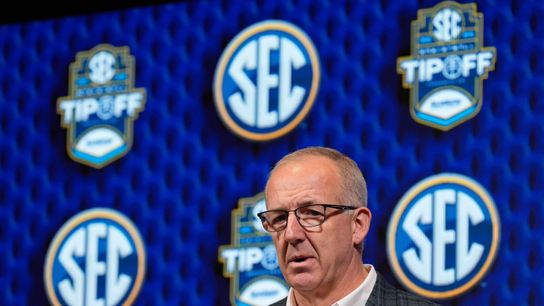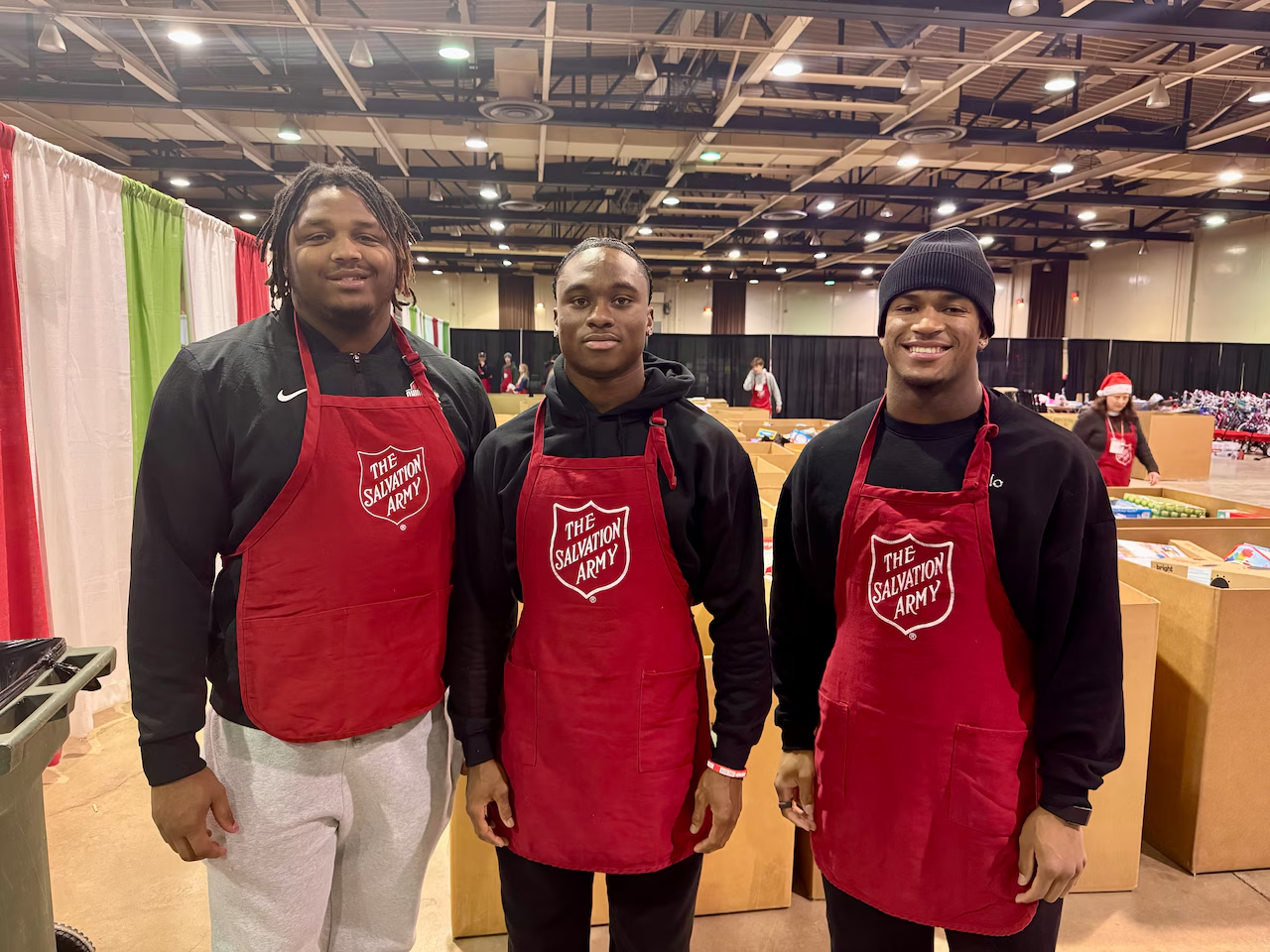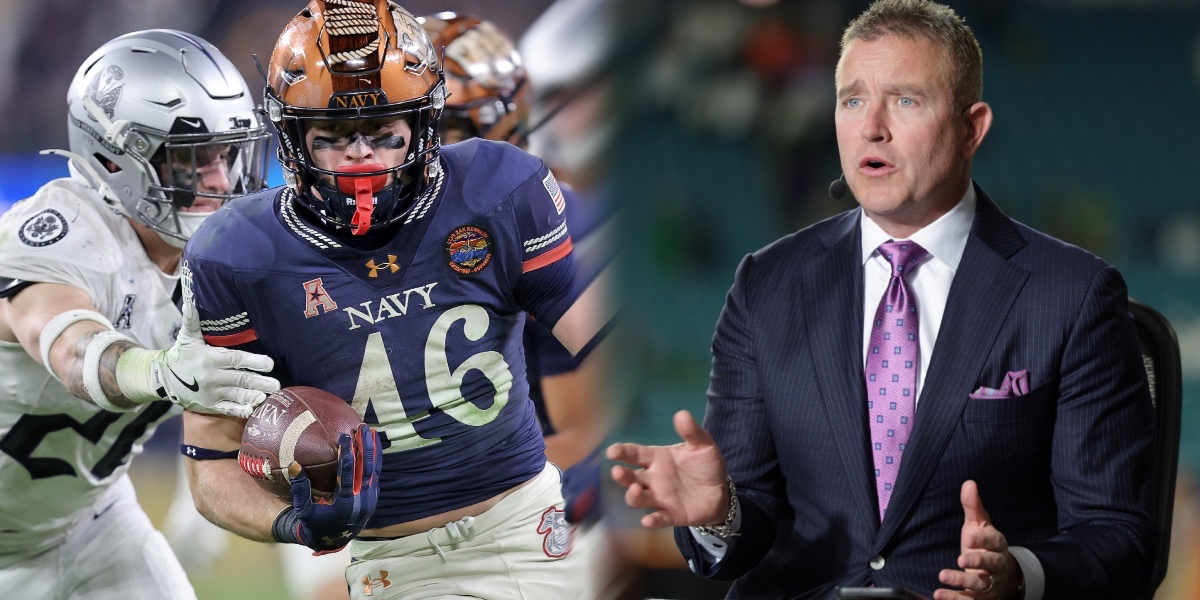NIL
In the debate for the College Football Playoff’s future, the tail is wagging the dog

We finally got an answer as to how and why the Big Ten came up with its cockamamie “4+4+2+2+1” proposal for the upcoming College Football Playoff format, to begin with the 2026 season. As reported by The Athletic‘s Scott Dochterman, the Big Ten has developed a healthy distrust that the selection committee will properly evaluate strength of schedules and instead get starry-eyed at the prospect of putting as many SEC teams in a 14- or 16-team field as the bracket will hold. This fear is not unfounded.
In 2017, the committee put in an 11-1 Alabama team that didn’t even win the SEC West over an 11-2 Big Ten champion Ohio State with three wins better than Alabama’s best regular-season victory. (One of Ohio State’s losses that season was at home to eventual Big 12 champion Oklahoma, the type of game all involved want to protect.) In 2018, 9-3 LSU and 9-3 Florida were selected for New Year’s Six bowls over 9-3 Penn State, despite Penn State playing tougher non-conference games and owning more defensible losses than the Tigers and Gators. In 2024 and beyond, those aren’t bowl trips up for grabs, they’re playoff bids.
The Big Ten’s data shows it would actually have gotten more teams in over the past four seasons with a 5+11 (auto-bids for only the five highest-ranked conference champions, at-larges for everyone else) model than the 4+ model, and yet that league prefers the objectivity of four guaranteed bids because, in its opinion, the Big Ten does not reap the rewards it should for playing nine conference games to the SEC and ACC’s eight.
And yet, the SEC is making the exact same complaint about the selection committee. The conference closed its annual spring meetings by distributing a PowerPoint deck that argued, in short, its eight games were more difficult than the Big Ten’s nine and it was the SEC who has been victimized by the committee.
The SEC has shared this packet on its football analytics to consider as College Football Playoff format dominates conversations. (Thread below) pic.twitter.com/UBkEjcvyVh
— Brandon Marcello (@bmarcello) May 29, 2025
Greg Sankey has made not-so-veiled threats to burn the entire system down if an 11-1 Indiana gets in over a 9-3 Alabama again. “It’s clear that not losing becomes in many ways more important than beating the University of Georgia, which two of our teams that were left out did,” he said last week. Sankey was also reportedly bothered that Nebraska canceled a planned 2026-27 home-and-home with Tennessee and has encouraged his schools to continue pursuing those sorts of matchups, but that could change if he and the rest of the SEC believe that getting to 11-1 or 10-2 by any means necessary is a pre-requisite for competing for a national championship.
The SEC has not formally endorsed a playoff proposal, but the general feeling from those on the ground in Destin last week was that the SEC entered the week open to the 4+ model, but left it in favor of 5+11. (Lane Kiffin endorsed the 0+16 model, with no automatic bids for anyone.)
Where are the Big 12 and ACC in all this? Sensing the ground shifting beneath his feet, Big 12 commissioner Brett Yormark strongly campaigned for a 5+11 format last week. Yormark did so knowing that arrangement may ultimately cost his conference bids from year to year. “We want to earn it on the field, and that was the direction of the key stakeholder group — the ADs and the coaches — and I feel very comfortable with that. And I feel the same way, and I’ve been very outspoken about it,” he said.
ACC commissioner Jim Phillips declined to endorse a specific model when asked earlier last month.
Why is the Big 12 supporting a format that might cost itself bids in the long run? In short, the 4+ model is un-American. I mean that literally and figuratively. The only comparable model that reserves championship access for a fourth-place team is the Champions League of European soccer. The NFL guarantees bids for its eight division champions, but nothing to a second- or third-place finisher. Similarly, every other NCAA tournament reserves a bid for conference champions only.
“The 5+11 might not be ideal for the conference, but it’s good for college football and it’s what’s fair,” he said.
Is the solution actually staring us in the face here? The Big Ten is campaigning to radically change the CFP format because of a mistrust in the committee’s ability to properly evaluate the rigor of its schedule. The SEC is making not-so-veiled threats to radically change the way it builds its regular season schedule, for the exact same issue. The two superpowers are talking past each other, when the solution is clear:
You don’t need to change the Playoff. You need to change how Playoff teams are evaluated and selected.
It’s long been argued that the Tuesday night ranking shows do more harm than good to the committee’s credibility. (You try explaining your personal Top 25, in a sport with as few data points as college football, in a logically consistent way from week to week and year to year.) The weekly rankings should have been eliminated by a full decade ago. The NCAA basketball committee releases periodic rankings throughout the season, which is a move that could be adopted if necessary. The NCAA also publishes its own metric (NET) by which the selection committee follows. College football leaders would be wise to consider something similar.
Before you come back with a rebuttal, I’m one step ahead of you. We tried that from 1998 to 2013, and people hated that, too.
What if we compiled a diverse set of opinions from around the country and combined them with a set of handpicked computer rankings? People will love it! https://t.co/F0dRIRDhrg
— Zach Barnett (@zach_barnett) May 27, 2025
A rebuttal to my own rebuttal: Frustration with the BCS was largely a square peg/round hole problem. There was simply no possible way to put more three or four deserving teams into a single championship game. The public is more accepting of computerized rankings in 2025 than it was in 1998, and especially so when used to break ties between 10-2 and 9-3 teams than the impossible task of selecting the No. 1 and No. 2-ranked teams in the nation.
Of course, the devil lives fully within the details here. I’m personally skeptical of any arguments, all of which seemingly originate out of SEC country, where “best” seems to be code for “Let’s just let recruiting rankings and hypothetical Vegas lines decide everything.” The portal and NIL have leveled the playing field, evidenced by the Big Ten’s back-to-back national championships and its 5-1 record vs. the SEC in the 2024-25 postseason.
A BCS-like system wouldn’t have to serve as a be-all, end-all, either. No one’s suggesting we turn the keys of a billion-dollar enterprise governing dozens of multi-billion dollar universities over to a souped-up version of Google Sheets without a set of checks and balances. Commissioners should select a set of rankings to serve as a tiebreaker to a more robust set of instructions that is less open to interpretation of the various individuals cycling in and out of the Gaylord Texan boardroom. Give the selection committee a detailed blueprint of how to build the house, and make them stick to it. It’s not perfect, but it’s better than pre-awarding a spot in a championship tournament to your fourth-place team, or shying away from playing marquee games out of a misguided desire to get to 11-1, no matter how.
When the College Football Playoff killed the BCS after the 2013 season, I never imagined arguing for dusting off its zombie-fied corpse a decade later. But, somehow, it seems more sane and less destructive to the fabric of college football than the alternatives.
NIL
Frustrated Ron DeSantis waits for Donald Trump to address college sports NIL issues

Gov. Ron DeSantis says college football is a “total mess” in light of athletes shopping around for better deals from programs, and that his efforts to reform it have been paused by Donald Trump’s White House.
Speaking in Sebring, DeSantis said he spoke to a bipartisan group of Governors “about a year ago” and said Governors on both sides of the aisle wanted to “come up with a framework.”
“Honestly, you really only need 10, 12 states, right? Because, you know, if you get Florida, Texas, Georgia, Alabama, Michigan, now you need Indiana, California,” DeSantis said, explaining that once states with “big-time programs” act, that would be enough to set up a workable structure.
But DeSantis said comments by Trump that the federal government planned to step in halted the state-led effort.
“So we’re like, all right, we’ll let the feds do it,” DeSantis added.

DeSantis said as early as last year that he wanted Governors to join him in some reform effort.
“I know they’re working on something, but I think it’s hit rock bottom just in terms of all the static that’s in the system,” DeSantis said.
He noted that “general managers” in college football make it “like a professional thing,” adding that many of the athletes recruited “haven’t even really produced that well.”
He also suggested that athletes are currently holding up programs for more money when they are performing.
“Now it’s like they have more rights than pro athletes,” he said.

“A quarterback will, you know, throw for four touchdowns. The third game of the season (he will) go, ‘Hey, coach, any more NIL money? Oh, I’m going to hit the transfer portal.’ And then you just go hop around schools. So you can play for four or five schools the way it goes now. And you can even play a few games, do very well, sit out and still get eligibility for the next year.”
Players’ mobility hurts programs, he argued.
“It’s hard to even know whether your teams are going to be good year after year because you don’t know who you’re going to lose. And then to do the transfer portal, right as we’re getting into the playoff, how does that make sense where these teams are going to have to make the decision?”
While the Governor stopped short of saying he regrets signing the name, image and likeness legislation that helped start the current cycle of professionalization of college sports, he does want a “happy medium” between athletes not being compensated and the current system.
But with time running out, reforms may not be realized before DeSantis leaves Tallahassee.
NIL
$64 million college football coach emerges as prime candidate to replace Sherrone Moore at Michigan

Less than a week after Michigan dismissed Sherrone Moore for cause, the Wolverines are navigating a condensed and high-pressure coaching search, with at least one prominent candidate already drawing serious consideration.
Michigan closed the 2025 regular season 9–3 (7-2 Big Ten) and will play No. 13 Texas in the Cheez-It Citrus Bowl on December 31 under interim coach Biff Poggi.
The program swiftly moved to remove Moore on December 10 after an internal probe concluded that there was an inappropriate relationship with a staff member.
While a cluster of candidates has emerged across national hot boards and analyst shows, college football analyst Josh Pate on Tuesday specifically singled out Missouri’s Eli Drinkwitz.
“I think Eli Drinkwitz’s name is involved here,” Pate said. “Names like Eli Drinkwitz get thrown out, and people are really quick to scoff at it… I have always been baffled by people who turn their nose up at Eli Drinkwitz. It’s well known in the SEC, he’s one of the better staffers in the country.”

A former offensive coordinator at Boise State and NC State who won a Sun Belt title at Appalachian State in 2019, Drinkwitz inherited Missouri in 2020 and built the program to back-to-back double-digit win seasons (2023-24) and an 8–4 showing in 2025.
That on-field progress led to a recent six-year contract extension in late November, which anchors him at roughly $10–10.75 million annually and includes significant buyout provisions.
Drinkwitz has also publicly pushed back on any rumors, calling coaching carousel speculation “just a distraction,” saying he loves Mizzou, is focused on the job, and recently signed an extension.
On the Michigan front, the program has indicated it hopes to finalize a hire before the end of December, a timeline that highlights how little margin the search affords.
In the next two weeks, expect intensified contact between Michigan’s search firm and top-tier candidates, a group many believe includes Drinkwitz.
Read More at College Football HQ
- $3.7 million college football head coach named clear candidate for Michigan vacancy
- College football program signs $1.2 million deal with NFL legend
- College Football Playoff team losing all-conference player to transfer portal
- $2.1 million college football QB announces return to Big Ten program
NIL
Talent pipeline developing between Carroll and Montana

HELENA — It’s been a two-way relationship between the Carroll College and University of Montana football programs.
Some guys who didn’t quite stick with the Grizzlies — like current Carroll quarterback Kaden Huot — have had success in Helena. And on the other side of the equation, a standout few have jumped up from the NAIA level to the Division I FCS level.
Each of the past two seasons, Carroll has produced the Frontier Conference defensive player of the year. And each time, that player has subsequently transferred to Montana.
“It shows well for our ability to develop,” Carroll head coach Troy Purcell told MTN Sports, “where they didn’t have that opportunity, and now with our coaching and our structure here and our culture here, to develop fine young men and great football players.”
On Dec. 10, Saints cornerback Braeden Orlandi — the NAIA’s reigning tackles leader — announced he was leaving Helena for Missoula. And the year before, it was NAIA All-American Hunter Peck trading Purple and Gold for Maroon and Silver. And following his first regular season with the Griz, Peck made the Big Sky all-conference first team, something he credits his time at Carroll for making possible.
“They did a great job with taking me in, developing me not (just) into a football player, but a young man, as well,” Peck said of his four years at Carroll. “And so, those life lessons are ones that you take off the football field and are arguably the most important part of the game.”
So, in this transfer-portal-and-NIL-dominated era of college athletics, the Carroll coaching staff said they understand their position in the larger college football ecosystem.
“Let us develop you. Let us make you the best you can possibly be for two to three years, get some tape, get some good film out there,” Purcell said. “You get some great ball in along the way. And then when the time is right, and it looks good, you have an opportunity to go up, maybe put a little money in your pocket, and get to play at a higher level. So, maybe that kid could be a walk-on but now has an opportunity to play for us, and like I said, we can develop him.”
NIL
Ohio State standout pauses College Football Playoff prep to use NIL for good: ‘I want people to feel loved’

COLUMBUS, Ohio — They wore red aprons, waited their turn in a line of volunteers and carried bags filled with toys through the Lausche Building at the Ohio Expo Center & State Fairgrounds.
In their actions, they were unassuming, helping bring holiday joy to families in central Ohio. But these volunteers were far from unrecognizable in Columbus.
They were safety Jaylen McClain, defensive tackle Eddrick Houston, safety Caleb Downs and running back James Peoples — a collection of some of Ohio State football’s top contributors this season.
And they were there to fulfill a vision of McClain’s.
The McClain family recently launched Everyday Legends — a foundation created to, “honor and uplift individuals who demonstrate excellence in scholarship, service, and sportsmanship.”
One of its first initiatives came via a partnership with the Salvation Army in Central Ohio. Courtesy of opportunities presented through college football’s name, image and likeness rules, McClain started a virtual toy drive in which donors could purchase toys through an Amazon wish list put together by the foundation with gifts going directly toward Wednesday’s event.
With his teammates working alongside him, McClain — who went to Target the day after Ohio State’s loss in the Big Ten Championship Game to ensure enough toys were purchased — helped those in a community far from his home state of New Jersey.
“I didn’t have everything, but my parents provided so much support for me and made sacrifices for my life,” McClain told cleveland.com. “Now that I have a bigger platform for myself as a college football player and NIL, I’m able to give my blessings off to other people, other foundations and be able to recognize other people that also have the blessings.”
As the foundation’s name suggests, McClain co-founded this venture with intentions of helping everyday people in our lives. His goals range from toy drives to buying uniforms for his youth football team and helping his high school, Seton Hall Prep.
“The intended goal is to provide support for any initiatives in any of those pillars (athletics, scholastics and community),” said Syreeta McClain, Jaylen’s mother.
“Your influence really carries,” she later added. “It carries some weight, so people are willing to give and people are willing to donate and make an impact. It really helps to make an impact. That’s the intended goal in all this: to be able to transcend the sport.”
Jaylen grew up in a family familiar with football.
One of his brothers, KJ McClain, recently signed with Tennessee. Another brother, Cameron McClain, is in the 2028 class with offers trickling in.
His father, Maurice McClain, played at Syracuse (1998-2001) and overlapped with Matt Patricia — a former graduate assistant for the Orange who is now Ohio State’s defensive coordinator.
Athletes such as Maurice didn’t have NIL privileges to help get through college, but his sons are experiencing a new era in the sport. They’re leaning on those opportunities to grow their foundation.
“He’s just like, ‘You’ve got the platform. Use it. If you could do it, then you should be able to do it. It goes a long way and helps other people as well,’” Jaylen said.

Others in Ohio State’s locker room have taken a similar approach in utilizing their NIL privileges.
In July, Downs’ foundation held an event at Topgolf in Columbus to raise awareness for families experiencing homelessness. Many Ohio State players and coaches were present for it.
While helping those in need, Downs also provided a blueprint for how NIL should be used in Columbus.
“He’s a great role model for not just me, but a lot of other people on this team,” Jaylen said. “… Just to be around him every day, I get to soak in a lot of stuff and just learn so much from him. To see how he carries himself, how he moves in terms of community service and how he moves on the field – obviously, it means a lot to me.”
The willingness to help comes without a need to ask, Jaylen added.
When word started to spread about Everyday Legends working with the Salvation Army, players reached out to Jaylen with intentions of assisting.
“We’re not just all about football. We actually have a soul, too, and care about others,” Houston said.

The toy drive, in part due to the effort of Everyday Legends, will provide gifts for more than 4,000 families in the area during the holiday season.
Jaylen hopes it’s only the start of creating a larger legacy in Columbus, which is also fueled by his play as Ohio State prepares for the upcoming College Football Playoff.
“I just want to be able to give back,” Jaylen said. “I want people to feel supported. I want people to feel loved.”
NIL
Everyone caught up to Oregon’s business model. Can Ducks win it all in a world they pioneered?

After decades of milestone wins on its climb to college football powerhouse status, Oregon found itself on the other side of a signature victory this season.
As Indiana celebrated on the Ducks’ home field on Oct. 11, an Oregon staffer shook the hand of a Hoosiers assistant coach and congratulated him on a 30-20 win that helped validate IU as a national championship contender.
“We’re hard to beat,” the Oregon staffer said.
No doubt. Since joining the Big Ten last year, the Ducks are 17-1 in conference play and 24-2 overall, with a league title in their debut season. Since 2010, Oregon is tied for fifth in the nation in victories with Oklahoma at 161. Only Alabama, Ohio State, Clemson and Georgia have more.
“We’ve been building to a standard of what winning football looks like, regardless of conference,” head coach Dan Lanning said this week.
After the Ducks spent years breaking through barriers that previously required something akin to birthright status for entry, college football has met them where they are. Adaptability and innovation are cornerstones of the Oregon brand, so of course, no school was better prepared to succeed when NCAA amateurism crumbled and the ability to effectively pay players became a necessity for programs that aspire to win national championships.
Oregon football has never been better, but the Ducks are no longer college football’s gate-crashers.
“There’s been some great stories in college football, but it’s even harder to stay there, and (the Ducks) have found a way to stay there,” said Craig Pintens, who was a high-ranking administrator at Oregon from 2011 through ’18 before becoming athletic director at Loyola Marymount.
In this year’s College Football Playoff, Indiana, Texas Tech and Ole Miss are the new-money climbers, no longer constrained by their histories.
The Ducks? Heading into a first-round home game against 12th-seeded James Madison on Saturday, they are just another team trying to win a championship.
Well, maybe not just another team.
You see, Oregon is not quite a member of the establishment class, either. It has a lot more in common with Ohio State, Georgia, Oklahoma, Alabama and Miami these days than with the Hoosiers, Red Raiders and Rebels — with one notable exception.
That first group has combined for 13 national titles since 2000 and 34 in college football’s poll era, dating to 1936.
The Ducks are still seeking their first.
“They’ve built the entire sundae at this point,” Pintens said. “It’s just a matter of putting that cherry on the top. And it is inevitable. It’s going to happen.”
College football has never cultivated upward mobility. Past success is the best predictor of future success. Lineage and tradition are prized commodities.
The schools at the top of the food chain tend to stay there — or have an easier time getting back when they slip. Those toward the bottom generally get stuck.
There are outliers. Nebraska looks as if it may never recreate the glory days of the 1970s, ’80s and ’90s. Clemson went from good to elite under Dabo Swinney, but that era of dominance is increasingly looking like a moment in time rather than a permanent change.
And then there’s Oregon, the most obvious exception that proves the rule.
The Ducks didn’t have USC’s Heritage Hall, a shrine to a program that claims 11 national titles and eight Heisman winners. They didn’t have Touchdown Jesus, Notre Dame’s iconic monument to the program’s essential place in the history of college football.
“We didn’t have the kinds of things that Ohio State and Texas and all these legacy programs had, but we did feel like we had a chance,” former Oregon athletic director Pat Kilkenny said.
The first baby step toward Oregon shedding its history came in Shreveport, La., of all places, with quarterback Bill Musgrave leading coach Rich Brooks’ Ducks to a victory in the program’s first postseason game in 26 years, the 1989 Independence Bowl against Tulsa.
The mid-1990s featured trips to the Rose and Cotton bowls that signaled progress but also showed the Ducks still had a long way to go: Oregon lost those games to Penn State and Colorado by a combined score of 76-26.
Nike co-founder and Oregon alum Phil Knight’s involvement and investment in the program brought a grander vision in the early 2000s. Why not put up a billboard in Times Square to promote quarterback Joey Harrington as a Heisman Trophy contender in 2001?
“I think our optimism was more about Holiday Bowl and Top 25,” said Kilkenny, an Oregon native. “But somebody like Phil Knight gets involved, that doesn’t work for him. He doesn’t want to do anything unless he can be the best.”
Oregon football had no distinguishing characteristics, so Knight helped create them.
With Nike’s help, Oregon made uniforms a differentiator in recruiting, unveiling a fresh look almost weekly.
“Being fashion-progressive isn’t exactly indicative of a strong football program, but (Knight) saw it as brand-building,” Kilkenny said.
The Ducks were on the front end of the spread offense revolution under coach Mike Bellotti, then promoted Chip Kelly to head coach and changed the way the game was played by optimizing fast-paced football.
When the facilities arms race was escalating, Oregon built its so-called Death Star, a tinted-glass fortress with a barber shop, sleep pods and tech-integrated lockers. The $68 million Hatfield-Dowlin Complex, funded largely by Knight, opened in 2013.
The Ducks reached the national championship game in 2010 and 2014, losing each time.
They haven’t been back since, which suggests the ascent has stalled. That’s not the case. Through a whirlwind of coaching changes from Kelly’s successor, Mark Helfrich, to Willie Taggart to Mario Cristobal to Lanning in the span of only seven years, Oregon was still progressing.
“I think they’ve built a tremendous culture, and that culture has turned over through multiple coaches,” said Pintens, who credits his former boss, athletic director Rob Mullens, with overseeing the continued growth at Oregon.
Even with Knight’s backing, Oregon is not among the top revenue-generating programs in college football.
“Oregon is not as resourced as some of the other top powers in college football,” Pintens said. “They lack a population base. They don’t play in a huge stadium.”
Autzen Stadium’s gameday experience is one of the best in the country, but the place seats about 56,000, about half the capacity of the largest stadiums in the Big Ten and SEC.
When Oregon spends, it spends on what matters most.
“If you want to be a top-10 team in college football, you better be invested in winning,” Oregon’s Dan Lanning said earlier this season in response to then-Oklahoma State coach Mike Gundy’s comments about how much the Ducks’ roster costs. “We spend to win.”
In 2020, the NCAA lifted its ban on paying college athletes for their name, image and likeness. Quickly, those deals became a proxy for paying players, and Oregon was again an early adopter. Founded by Knight and other prominent donors, Division Street quickly became one of college football’s most well-run NIL collectives, groups that pool funds from boosters to license players’ rights.
Taggart and then Cristobal had already changed the nature of Oregon recruiting, turning the school into a destination for blue-chippers, despite the school’s limited number of those prospects within its geographic footprint.
Lanning was hired away from Georgia to keep that going in 2021. His ability to embrace a more transactional form of recruiting while still establishing a winning culture has allowed Oregon to narrow the gap between itself and the likes of Ohio State and Georgia.
NIL has been “an equalizing force,” Pintens said.
“You could have better facilities, you could have better coaching, better everything, but at the end of the day, if you don’t have any dollars to support that, it’s going to be really difficult to put together a team,” he said.
The transformation that took Oregon decades is happening much faster elsewhere, as paying players spreads talent around and gives the traditional have-nots a chance to become haves.
“The historical programs that weren’t able to compete, it did give them a chance to put a little jet propulsion into their football program, if that’s where they chose to invest,” Kilkenny said.
Fourth-seeded Big 12 champion Texas Tech, with a roster backed by billionaire booster Cody Campbell that reportedly cost more than $28 million, this season won its first outright conference title since 1955.
In the SEC, sixth-ranked Ole Miss has effectively mobilized its resources with the Grove Collective and ripped off three straight double-digit victory campaigns while LSU and Florida (with a combined six national titles) fired their head coaches this season.
In the Big Ten, Indiana, which started the year having lost more games than any other major college football program, has turned unprecedented investment into an unfathomable turnaround under coach Curt Cignetti. The Hoosiers kept rolling after the win in Eugene, knocked off Ohio State in the conference title game, and enter the Playoff as the No. 1 team in the country, boasting the program’s first Heisman Trophy winner in quarterback Fernando Mendoza. The Ducks are no longer the disruptors.
“The willingness and the belief in taking what had been done and saying, OK, we can be No. 1,” Kilkenny said. “We can win it all, and we can be a national brand, that has all happened.”
Oregon’s challenge now is not just to check the last box on the resume and join the blue bloods once and for all but to keep the new wave of gate-crashers from jumping ahead of them in line on the way to the top of the mountain.
NIL
Kirk Herbstreit issues an apology for misunderstood post following Army-Navy game

Kirk Herbstreit drew the ire of the college football world earlier this week. Now, he’s moving quickly to clear the air after a social media post sparked backlash following the Army–Navy game.
Herbstreit, who’s become the face of ESPN’s college football coverage, addressed the situation in a lengthy post on X (formerly Twitter). He apologized for what he described as a misleading caption attached to a video clip promoting his Nonstop podcast with colleague Joey Galloway.
“Just wanted to address a mistake that we made on my socials earlier this week related to last weekend’s CFB Saturday,” Herbstreit wrote. “We posted a video where Joey Galloway and I were talking about how strange it was to be home and not traveling on a CFB weekend since the end of August and how we felt like we didn’t know what to do with ourselves. We posted the video with a caption that was very misleading about ‘Weird not having any CFB this weekend.’”
Herbstreit acknowledges that the wording created a bit of confusion, appearing dismissive of games that were played, most notably the Army–Navy Game: “Some took that out of context and ran with it. That’s on me,” he wrote. “My apologies for any disrespect (albeit unintentional) to the teams that played last weekend, especially [Army] and [Navy].”
The original post, which has since been deleted, included a clip from the podcast with the caption, “Saturday not having college football threw us for a loop,” accompanied by a laughing emoji. That message quickly drew a response from Navy Athletics, which quote-tweeted the post with a photo from Saturday’s game.
More on Kirk Herbstreit, Army-Navy controversy
Alas, Navy went on to defeat Army 17–16 in one of college football’s most iconic rivalry games, a matchup that has occupied a standalone window on the Saturday following conference championship weekend for years. While it has no impact on the College Football Playoff, the game remains one of the sport’s most-watched events, averaging 7.84 million viewers on CBS.
In his apology, Herbstreit emphasized that the Army–Navy Game remains one of his favorite events on the college football calendar: “Not sure there is a game I personally look forward to more EVERY year than Army and Navy,” Herbstreit added.
“They play for the love for each other and love for the game. Anybody who has ever watched me for the last 30 years on TV knows how I feel about that game.”
Beyond Army–Navy, last weekend still featured a full slate of college football action. Bowl season opened with Washington facing Boise State, the FCS playoffs held quarterfinal games, and South Carolina State defeated Prairie View A&M in the Celebration Bowl.
Listening back to the deleted clip itself, Herbstreit and Galloway never actually stated there was no football being played. Instead, they reflected on the unfamiliar feeling of being home for the first time since August without their usual travel routine.
Still, the initial caption struck a nerve. It highlighted how easily attention can drift toward the Playoff and power conference landscape at the expense of the broader sport.
Herbstreit closed his statement by reiterating that the controversy stemmed from miscommunication, not disrespect. At the least, he felt it necessary to publicly address the situation, and let the college football world know he meant no ill-will towards Army-Navy.
-

 Motorsports3 weeks ago
Motorsports3 weeks agoJo Shimoda Undergoes Back Surgery
-

 Motorsports1 week ago
Motorsports1 week agoSoundGear Named Entitlement Sponsor of Spears CARS Tour Southwest Opener
-

 NIL3 weeks ago
NIL3 weeks agoBowl Projections: ESPN predicts 12-team College Football Playoff bracket, full bowl slate after Week 14
-

 Rec Sports3 weeks ago
Rec Sports3 weeks agoHow this startup (and a KC sports icon) turned young players into card-carrying legends overnight
-

 Rec Sports3 weeks ago
Rec Sports3 weeks agoRobert “Bobby” Lewis Hardin, 56
-
Sports3 weeks ago
Wisconsin volleyball sweeps Minnesota with ease in ranked rivalry win
-

 Motorsports3 weeks ago
Motorsports3 weeks agoPohlman admits ‘there might be some spats’ as he pushes to get Kyle Busch winning again
-

 Motorsports1 week ago
Motorsports1 week agoDonny Schatz finds new home for 2026, inks full-time deal with CJB Motorsports – InForum
-

 Motorsports3 weeks ago
Motorsports3 weeks agoIncreased Purses, 19 Different Tracks Highlight 2026 Great Lakes Super Sprints Schedule – Speedway Digest
-

 Rec Sports2 weeks ago
Rec Sports2 weeks agoHow Donald Trump became FIFA’s ‘soccer president’ long before World Cup draw






























